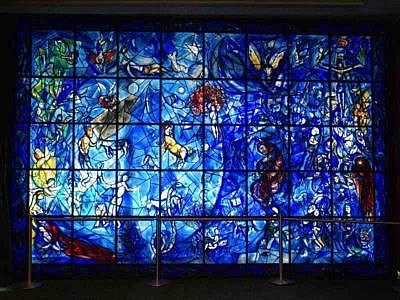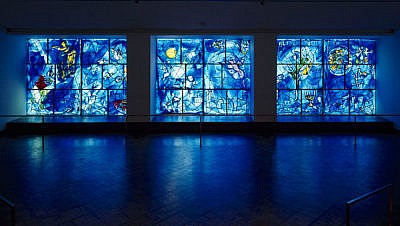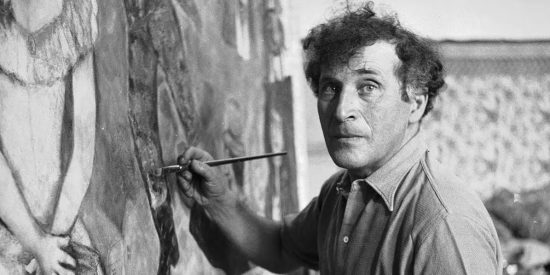Known for his exquisite palate and control of color in his graphic oeuvre, Marc Chagall's stained glass windows are no exception. The artist didn't create artworks of stained glass until his 70's and are now commissioned by churches and cathedrals around the world.
Known for his exquisite palate and control of color in his graphic oeuvre, Marc Chagall's stained glass windows are no exception. This incredible talent permeates his later work with the stained glass medium as well. It was not until Chagall was in his 70’s that he began to create artworks of stained glass*. The quality of the glass, along with the placement where light would shine through them, allowed him to exploit the properties of glass and get unimaginable coloration. This was only enhanced by the illumination of light. Many, but not all, of Chagall’s stained glass windows were commissioned by various churches and cathedrals – the religious nature of the building is reflected in biblical subject matter of the windows. Chagall worked in collaboration with Charles Marq at the Jacques Simon Workshop on many of his commissions both in France and internationally.
It might come as a surprise to some that Chagall has created stained glass works all over the world. We shall begin in Europe.
St. Stephen’s in Germany is the only German church that Chagall worked on commission for during his life. Chagall completed 6 windows in the east chancel and 3 windows in the transept. The commission was viewed as a sign of goodwill between the Jewish and Christian faiths. He collaborated on this project with Charles Marq, and finished the final window just before his death in 1985.

Chichester Cathedral in England is the site of another, smaller, commission. Walter Hussey, the Dean of Chichester, saw the Jerusalem windows on exhibition at the Louvre in 1960. Marveled by these works, he commissioned Chagall to make a window for the cathedral. Unlike the rich blue colors that mark much of Chagall’s glass, the primary color of this window was red. It mirrors the colors of the Benker Schirmer tapestry displayed close by.

All Saints’ church in Tudeley has a numerous 12 windows by Chagall created in a blue color scheme.

Saint Etienne in Metz, also referred to as the Metz Cathedral, has one window, created in 1963. The window depicts Adam and Eve and was damaged in 2008 when someone broke into the cathedral.
The Reims Cathedral commissioned 6 lancet windows and 3 rose windows. This work, started in 1968 and completed in 1974, was done in collaboration with the Jacques Simon Workshop. The cost of the project was 47,000 euros and it was funded by donations from the Committee of Builders of Champagne-Adrenne. The Reims Cathedral, an excellent example of Gothic architecture, was constructed between 1211 and 1516. Stained glass windows were first installed in the medieval period, but since that time, many have been lost or damaged. This opened space for new stained glass windows – which is where Marc Chagall comes in. He took great care to honor the colors of the medieval windows, asking Charles Marq to replicate the colors.

Chagall also created a series of stained glass windows in the United States.
One of the largest is the so-called “Peace Window” at the United Nations building in New York City. The window was made in memoriam of Dag Hammarskjøld, the Secretary-General of the UN who was killed in a plane crash in 1961. The glass contains symbols of peace and also musical notes referencing Beethoven’s Ninth Symphony, a favorite of the deceased Hammarskjøld.

Union Church in Pocantico Hills, New York was built by John D. Rockefeller Jr. in the 1920’s. His wife, Abby Aldrich Rockefeller, was a great patron of the arts and this is reflected in the church. Not only was Chagall commissioned to create multiple memorial windows, but Henri Matisse created the rose window for the church – the last work he finished before his death. The “Good Samaritan” window was commissioned by David Rockefeller in 1963 to memorialize his father, John D. Rockefeller. Other windows in the church made by Chagall memorialize Michael Clark Rockefeller, Governor Nelson A. Rockefeller, Peggy Rockefeller, and Mary Rockefeller.

Perhaps one of the most fun anecdotes one might come across while researching Chagall’s stained glass windows, is that of the “America Windows” at the Art Institute of Chicago. Chagall was visiting Chicago in the early 1970’s while working on his mosaic The Four Seasons for the Chase Tower Plaza. He was inspired by the commitment to public art, and offered to make windows for the museum. Upon completion of the windows, it was decided that they would commemorate the 200th birthday of the United States of America. The six panels “[celebrate] the country as a place of cultural and religious freedom, detailing the arts of music, painting, literature, theater, and dance.” For film buffs and other pop culture enthusiasts, these windows might ring a bell as those that Ferris Bueller and co. visited in the iconic movie Ferris Bueller’s Day Off (1986).

Bibliography
Art Institute Chicago. “Chagall’s America Windows.” Accessed January 26, 2017. http://www.artic.edu/exhibition/Chagall
Historic Hudson Valley. “Union Church of Pocantico Hills.” Accessed January 26, 2017. http://www.hudsonvalley.org/historic-sites/union-church-pocantico-hills
Mainz. “St. Stephen’s – Chagall’s mysticism of blue light.’ Accessed January 26, 2017. https://www.mainz.de/en/worth-seeing/st-stephen-chagall-mysticism-of-blue-light.php
Reims Cathedral. “The windows of Marc Chagall.” Accessed January 26, 2017. http://www.reims-cathedral.culture.fr/windows-chagall.html
United Nations. “Chagall Window: United Nations Headquarters.” Accessed January 26, 2017. http://www.un.org/depts/dhl/dag/chagallwindow.htm
*As an Amazon Associate I earn from qualifying purchases.











